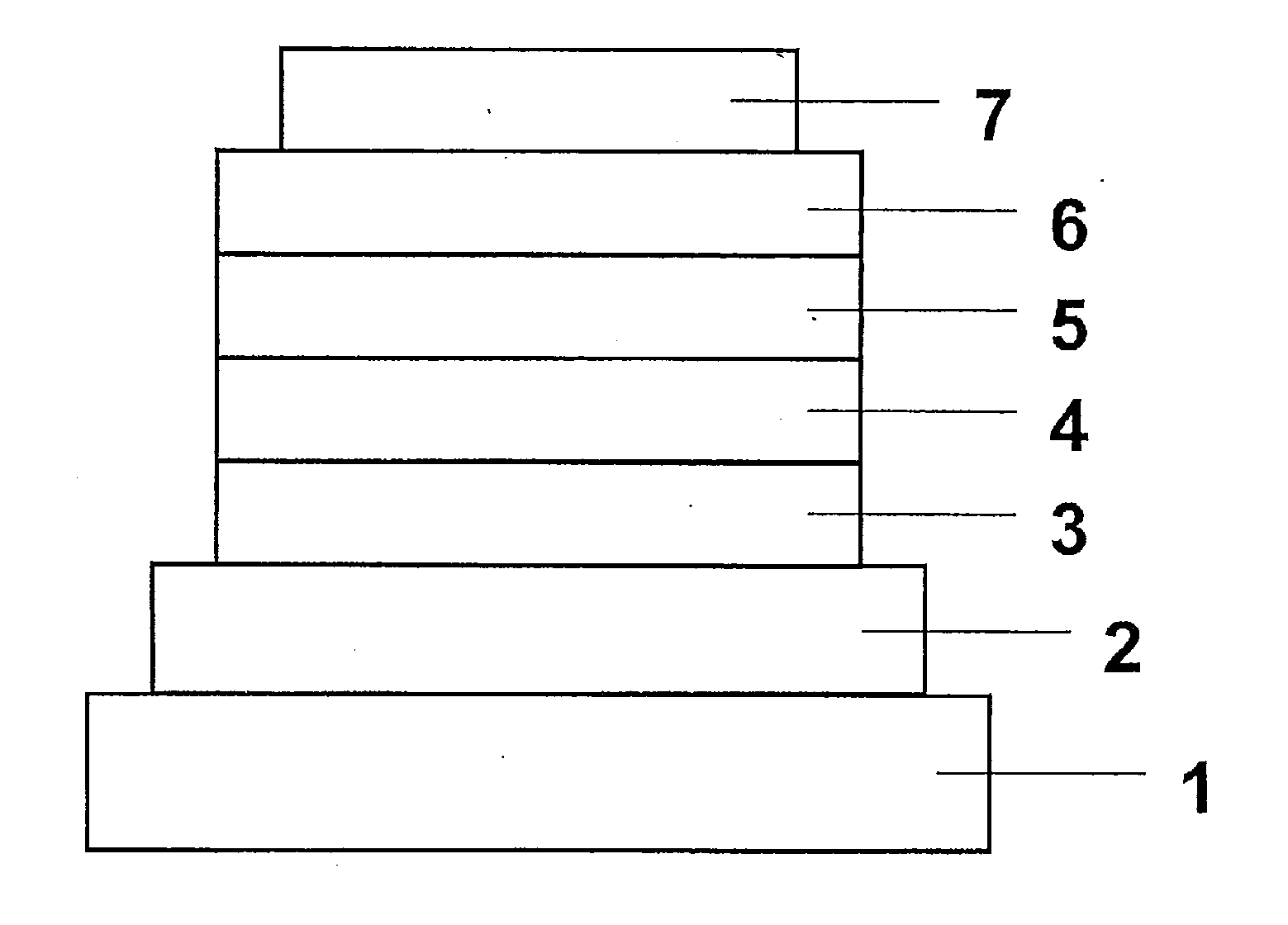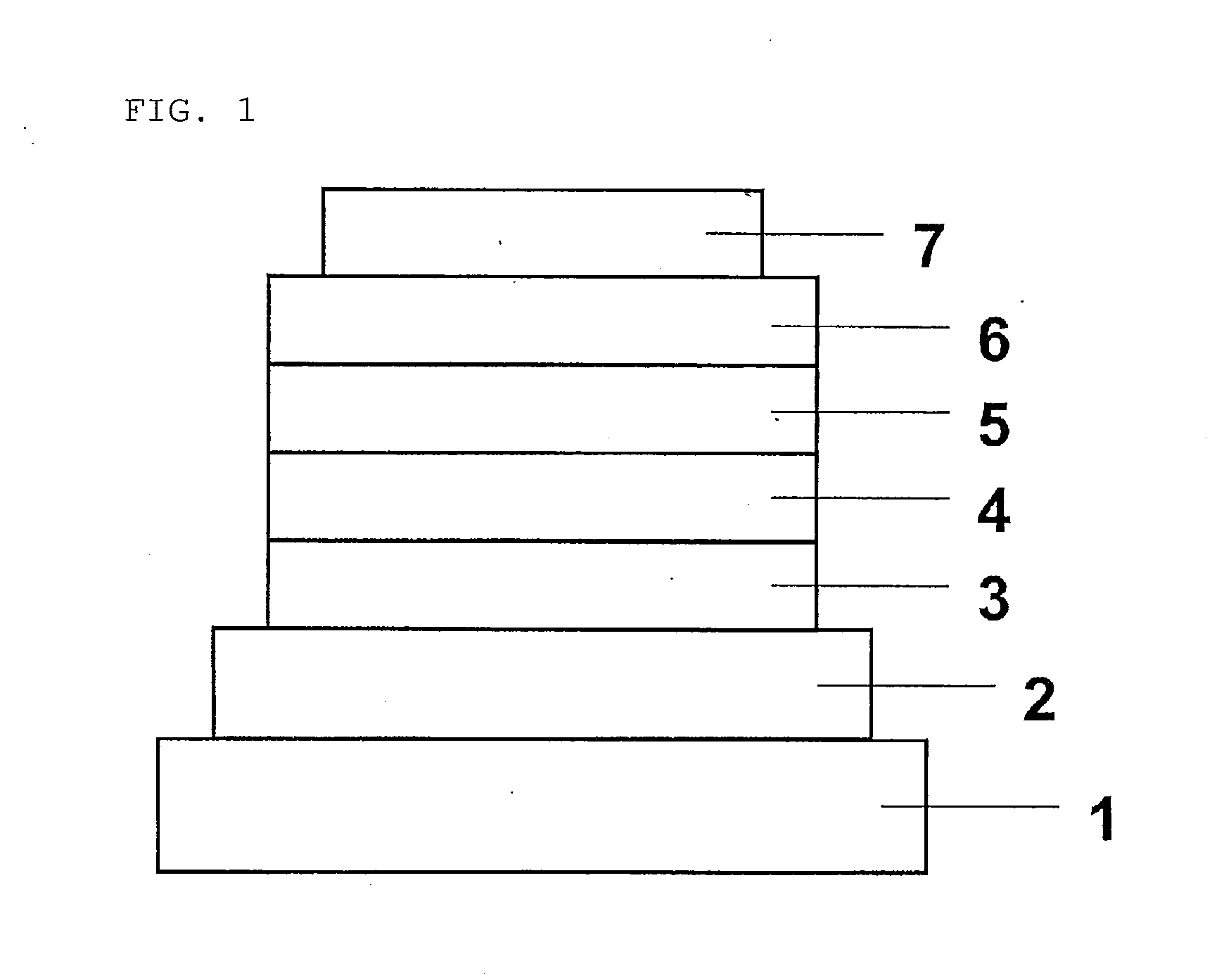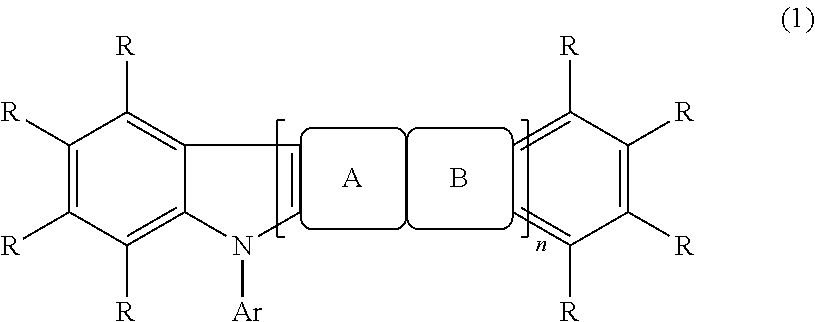Organic light-emitting material and organic light-emitting element
a technology of organic light-emitting elements and light-emitting materials, which is applied in the field of organic light-emitting materials and organic light-emitting elements, can solve the problems of not obtaining high quantum yield in many general cases, providing significantly lower luminous efficiency than a theoretical value, and none of the literatures disclose the relationship between luminous efficiency and luminous efficiency. achieve high efficiency and practical
- Summary
- Abstract
- Description
- Claims
- Application Information
AI Technical Summary
Benefits of technology
Problems solved by technology
Method used
Image
Examples
synthetic example 1
Synthesis of Compound (11)
[0072]33.3 g (297.0 mmol) of 1,2-cyclohexanedione and 86.0 g (594.7 mmol) of phenylhydrazine hydrochloride were loaded into a 2,000-ml three-necked flask subjected to degassing and nitrogen purging, 1,000 ml of ethanol were added thereto, and the mixture was stirred. After that, 3.0 g (30.6 mmol) of concentrated sulfuric acid were added dropwise to the flask over 5 minutes and the mixture was then heated to 65° C. and stirred for 4 hours. The resultant mixture was cooled to room temperature and the precipitated purple-brown crystal was then collected by filtration. The crystal collected by filtration was washed by reslurrying twice with 500 ml of ethanol. The resultant was dried under reduced pressure to afford 80.0 g (280.5 mmol, 96.3% yield) of a purple-brown powder.
[0073]Next, 72.0 g (261.5 mmol) of the purple-brown powder described above were loaded into a 1,000-ml three-necked flask, 720 g of acetic acid and 72.0 g of trifluoroacetic acid were added th...
example 1
[0078]On a glass substrate, Compound (11) was deposited from the vapor from a vapor deposition source under the condition of a degree of vacuum of 5.0×10−4 Pa by a vacuum vapor deposition method so as to form a thin film having a thickness of 100 nm at a rate of 0.2 nm / sec. The produced thin film was irradiated with light having a wavelength of 337 nm with N2 laser. An emission spectrum from the thin film upon the irradiation was evaluated at a temperature of 5 K. As a result, fluorescence emission at 466 nm and phosphoresce emission at 486 nm were confirmed. Based on the wavelengths, the excited singlet energy and excited triplet energy of Compound (11) were found to be 2.66 eV and 2.55 eV, respectively. Further, a difference between the excited singlet energy and the excited triplet energy (ΔE) was 0.11 eV.
example 2 (
Example 2(R)
[0079]On a glass substrate, 1,3-dicarbazolylbenzene (mCP) was deposited from a vapor deposition source under the condition of a degree of vacuum of 5.0×10−4 Pa by a vacuum vapor deposition method so as to form a thin film having a thickness of 100 nm at a rate of 0.2 nm / sec. The produced thin film was irradiated with light having a wavelength of 337 nm with N2 laser. An emission spectrum from the thin film upon the irradiation was evaluated at a temperature of 5 K. As a result, fluorescence emission at 375 nm and phosphoresce emission at 420 nm were confirmed. Based on the wavelengths, the excited singlet energy and excited triplet energy of mCP were found to be 3.30 eV and 2.95 eV, respectively.
[0080]mCP is calculated to have excited singlet energy and excited triplet energy higher by 0.64 eV and higher by 0.4 eV, respectively, than the excited singlet energy and excited triplet energy of Compound (11).
PUM
 Login to View More
Login to View More Abstract
Description
Claims
Application Information
 Login to View More
Login to View More - R&D
- Intellectual Property
- Life Sciences
- Materials
- Tech Scout
- Unparalleled Data Quality
- Higher Quality Content
- 60% Fewer Hallucinations
Browse by: Latest US Patents, China's latest patents, Technical Efficacy Thesaurus, Application Domain, Technology Topic, Popular Technical Reports.
© 2025 PatSnap. All rights reserved.Legal|Privacy policy|Modern Slavery Act Transparency Statement|Sitemap|About US| Contact US: help@patsnap.com



